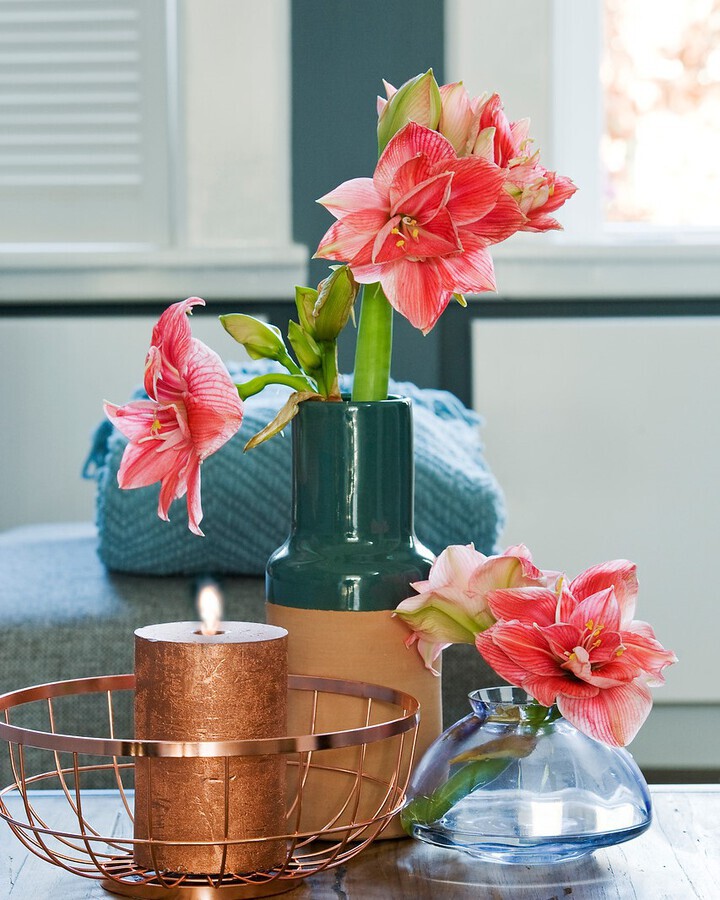It's impossible to walk past an amaryllis in full bloom without admiring its huge flowers and bright colors. Plus they bloom for several weeks in the winter—usually just in time for the holidays. They don't need much of your attention during the busy winter season either: All you have to do is give them a little water and warm, brightly lit spot, and they'll become beautiful showstoppers in just a few weeks. Still, there's a lot of interesting info behind these captivating plants that you might not be familiar with—we rounded up five of our favorite fun facts about amaryllis to help ring in the holidays.

1. Waxed Bulbs Don't Need Water to Grow
It doesn't get more low-maintenance than a plant that doesn't need to be watered at all. Waxed amaryllis bulbs don't need soil either because the wax holds in all the moisture and nutrients they need to bloom. Just plunk them down in a warm, brightly lit spot and they will do their thing. You can even hang them upside down for a fun way to display them. Although there are not as many colors available as regular amaryllis bulbs, the waxed versions still will produce gorgeous flowers you can enjoy through the holidays and sometimes even the wax is decorative, too. They also would make a unique gift for that impossible-to-shop-for person on your list.
Buy It: Cottage Farms Waxed Red Blooming Giant Amaryllis Bulb, $23.98, The Home Depot
2. The Name Amaryllis Has Roots in Greek Mythology
The story goes that amaryllis flowers sprung up from the blood of the nymph Amaryllis, who was madly in love with the handsome shepherd Alteo. That beautiful flower helped her win his heart. Perhaps that's why amaryllis today represents beauty and love, as well as determination, strength and success. You might also see amaryllis referred to as Hippeastrum, which is the genus name for these plants.

3. There Are More Colors Than Just Red and White
Some of the most common varieties you'll see have bright red flowers like 'Red Lion' or red-and-white blooms like 'Samba'. But among the hundreds of amaryllis varieties that exist, you can find plants that bloom in shades of pink, orange, yellow, green, purple, and multi-colors. Some are double-flowered, meaning they have more petals than usual so they look extra full. Some amaryllis flowers have frilly petals or skinny petals, too.
Buy It: Pre-Potted EuroBlooms Amaryllis Orange Sovereign, $13.74, Walmart
4. The Size of the Bulb Matters
As bulbs go, amaryllis are quite hefty. Some can get as large as softballs, but you may also see smaller ones closer to the size of a tennis ball. And no wonder they are so big—these bulbs usually produce two flower stalks and each can have between 2-5 individual blooms. When selecting bulbs, always try to get the largest ones you can find because they will produce the most flowers for you. And if you've ever wondered why these bulbs are on the pricey side (anywhere between $12 to $40 each), consider that it takes 3-5 years for them to grow large enough to market. Plus most of them are shipped to the U.S. from Holland or South America.

5. Amaryllis Can Rebloom Every Year
It might seem like a one-and-done plant after the flowers fade, but you can keep these bulbs going year after year with a little TLC. Once your bulb has finished blooming, cut the flower stalks down to about one inch above the bulb. Treat it like a houseplant, keeping it watered and letting it get sunlight during the spring and summer. Around mid-August, stop watering to let the plant go dormant. Once the leaves had dried up, cut them off and store the bulb in a cool, dark place for eight weeks. About 6-8 weeks before you want to see beautiful blooms again, move your bulb into a warm, bright spot and start watering again. In a couple of weeks, you should see some new growth happening. Once the flower stalks appear, add a stake to keep them from falling over.
It's always fun to display a few amaryllises around the holidays, and now you can wow your guests with your knowledge of this festive plant. We love these beautiful bulbs for their huge, colorful flowers that help make our days merry and bright; make sure you include one alongside classic poinsettias (or even cute red succulents) in your indoor garden this year.